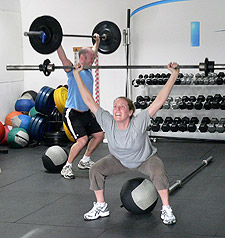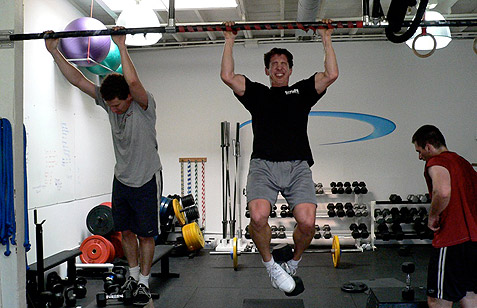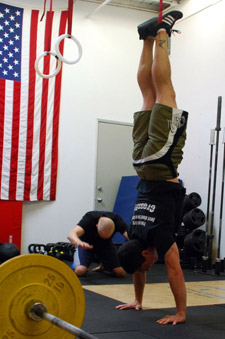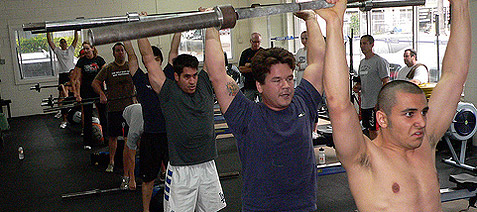
08/13/2009
Furci Home / Fitness Channel / Bullz-Eye Home
I talked recently with Andy Petranek, who owns Petranek Fitness/CrossFit LA. He has become the go-to guy after being featured in several stories covering one of the fastest growing fitness trends, CrossFit. Referred to as The Toughest Workout Ever! by “Muscle and Fitness Magazine,” CrossFit has seen the number of training facilities quadruple to more than 1,000 locations during the last two years.
We discuss how Andy got his start and what drew him as a top level sponsored athlete to CrossFit. We also begin to delve into the principles, the meat and potatoes, behind CrossFit, and how he employs these principles in his business.
Bullz-Eye: I really appreciate you taking the time to do this interview. Being a trainer and a strength coach for as many years as I have, I always welcome the opportunity to talk to other people who are involved in the business. Especially someone who is really making a name for themselves, like yourself.
Andy Petranek: Thanks a lot.
BE: Before we get into the whole CrossFit phenomenon, I would like to get to know you a little bit better. So if you could give us a little bit of a background about yourself. What did you do before becoming one of the premier trainers in L.A.?
AP: I don’t know where to start really. The down and dirty, kind of “Reader’s Digest” version, prior to anything athletic, I was 100 percent musician. I was a trumpet player. I went to the Eastman School of Music in Rochester, New York. I did no sports, no athletics up until I was in college. I got an ROTC scholarship to go to school. I shifted from Navy to Marines and then to get ready for Officer Candidate School, I trained my ass off. That was my first real indoctrination into being in shape. My Marine experience was very much fitness-related. I didn’t really know it at the time but I was responsible for making sure my Marines were fit for combat.
BE: Right, right.
AP: I didn’t really see my job as a fitness coach but essentially I was. I mean in addition to all the other stuff we train to do. I spent four years away. I got into mountaineering and outrigger paddling. And then I discovered adventure racing. I discovered Eco-Challenge in ’95, before anybody really knew what it was. I spent the next about seven years racing. I started off doing the long, long expedition races. I did four of those. And then through a series of kind of mistakes and mishaps, and not finishing races and frustration with teammates and stuff, I started doing some short ones and got sponsored by Red Bull and became team Red Bull. We competed for about five years on the short distance adventure racing circuit.
BE: Man, that’s excellent.
AP: At the same time when I was racing, it just kind of evolved into a training business. I then did go back to school. I went to UCLA; they have a fitness instructor program. I went through their kind of adult education -- it’s called UCLA Extension. I went back to the C.H.E.K. Institute in San Diego, which is an advanced kinesiology…
BE: I’ve heard so much about the C.H.E.K. Institute. I’ve heard that is an excellent place to go.
 AP: I don’t use much of it anymore except it rounds out my background. I use it to assess and look at mechanics and whatnot with people. And then I retired from adventure racing in 2004 and discovered CrossFit almost right at the same time. I didn’t know what my next thing was going to be. I was kind of bored. I was a trainer, I was working out in gyms but I didn’t really like working out in gyms. I wasn’t really motivated to get back on my bike and do some of the training I was doing before. So I was running a lot and I came across CrossFit. I was very skeptical of everything that they said essentially. I looked at the WODs (Workout Of the Day) that were rarely longer than 25 minutes, and they said that they could create elite fitness. I thought, yeah right, how is it possible to do that? Because my background told me that if it wasn’t at least 45 minutes, it wasn’t even worth doing.
AP: I don’t use much of it anymore except it rounds out my background. I use it to assess and look at mechanics and whatnot with people. And then I retired from adventure racing in 2004 and discovered CrossFit almost right at the same time. I didn’t know what my next thing was going to be. I was kind of bored. I was a trainer, I was working out in gyms but I didn’t really like working out in gyms. I wasn’t really motivated to get back on my bike and do some of the training I was doing before. So I was running a lot and I came across CrossFit. I was very skeptical of everything that they said essentially. I looked at the WODs (Workout Of the Day) that were rarely longer than 25 minutes, and they said that they could create elite fitness. I thought, yeah right, how is it possible to do that? Because my background told me that if it wasn’t at least 45 minutes, it wasn’t even worth doing.
BE: Right.
AP: So I just decided to try a workout. And I tried a workout and got my ass handed to me and I loved it. It was fun. I was suddenly kind of re-energized about working out. And so I did a little bit of my own litmus test. I went out and ran a 5K and I eliminated every other aspect of my training expect CrossFit for two months. My running mileage dropped by about -- I went from like 35 miles a week to about 5 miles a week. You know, no kayaking, no road cycling. All the stuff that I used to do I eliminated. I did CrossFit for two months and my 5K time dropped at the end of that two month period by 2½ minutes.
BE: Wow! That’s a heck of a drop.
AP: And I thought this is a miracle. This was amazing to me because I was resting more than I had rested in like seven years of training. I would take more days off. I was spending way less time working out. I mean, I was maybe at the most, training six hours a week. Maybe seven hours a week. My lightest week in seven or eight years of training was like nine hours a week. You know, my heaviest were at like 19 hours or 20 hours. So it was a ridiculous recovery period for me and I was getting faster. So I was immediately converted. I mean that day that I ran the 5K, I called Glassman and went up north to their next certification, which they had basically just begun their certifications. Got certified, came back down here and started looking for a spot to open my own -- I had been looking for a place to open, and with CrossFit, I suddenly saw a way to make it a reality, like to make it really, really work. CrossFit L.A. opened our doors in November of 2004. Now we’re going like gangbusters; we’re doing great.
BE: Awesome. That’s really cool. Andy, we’re going to get into the form and some of what you feel are the positive principles of this type of training in a little bit. But for our readers -- because obviously there are readers from all levels and types of fitness backgrounds -- in a nutshell, what is CrossFit? How would you describe it? And I know that’s probably a monumental task that I am asking of you.
AP: It’s a great question. You know people ask that question all the time and it’s very hard to encapsulate in a very pithy statement. We work on it a lot. CrossFit is a workout system that incorporates elements of gymnastics, Olympic weight lifting and metabolic conditioning. You know, running, rowing, cycling, jumping rope. That combines those elements at high intensity with lots of variety to create what we call elite fitness.
BE: Kind of an overall fitness.
AP: Yeah, to create the world’s fittest athletes in any discipline. In any realm. Our specialty is in not specializing. I was just interviewed by someone the other day who wanted me to say “well what is really the focus of CrossFit?” And I said “well, the focus is there is no focus.” We don’t want a hole in our armor.
BE: Well I would like to let our readers know what some of your training philosophies are in general, and concerning CrossFit. I really was attracted to its simplicity and uniformity. For instance, when you mentioned earlier the WOD -- the workout of the day -- can you give me your thoughts, both positive and negative concerning WODs?
AP: Well, I think from the standpoint of it’s very difficult for a beginner to get CrossFit. Because a WOD -- you know they look at a WOD and go “okay, what’s CrossFit?” Let me do a workout. They do a workout and -- like we had a person come and do a workout the other day. It was three cleans, two push presses and one over head squat, as many rounds as you could do in 20 minutes. So she comes and does the workout and goes “wow, I don’t really want to get buff and this is all weights.” I said look, you can’t get CrossFit in one workout. You can’t get CrossFit in five workouts. CrossFit takes place over time. So to get CrossFit you’ve got to give it four months. Which is one of the reasons why our basic membership is a four-month membership. Nobody can come in for less than a four-month period because you can’t get it. You don’t know what it is. It’s not like pick and choosing an aerobics class or a spinning class, where basically, if you go to a spinning class, every time you go to a spinning class you get spinning. You know what it is; you know exactly what spinning is every time you go to a spinning class.
BE: Right. I see where you’re going with this. It’s the same explanation I would use with my training clients. It’s like trying a diet for a day to see if it works.
AP: Exactly, so that’s a pro and a con. I think the pro of that is that’s incredibly diverse and incredibly fun. And very difficult to get old and stale. As a con, you’ve got to stick with it.
BE: Right. Now I noticed on your website, www.crossfitla.com concerning the WODs. Yours are different than the one that is actually on CrossFit.com. Is there a method of any kind, or a system to creating the WOD, or is it literally just a total random haphazard thing?
AP: It’s definitely not random. It seems like random if you haven’t really looked at what’s going on. But it’s definitely not random. We don’t have upper body days and lower body days. We don’t try and prevent you from doing the same thing two days in a row. We have weeks go by where pull-ups are in almost every workout. Because we feel that simulates real life. If you’re a construction worker and you’re digging a trench, if you don’t finish Monday -- guess what, you’re going to dig Tuesday. And if you don’t finish Tuesday you are going to dig again on Wednesday. You don’t tell your boss sorry; my muscles need a day off. This is not good for me; I’ll start again on Wednesday. No, you keep digging. So life throws stuff at you where you’ve got to do stuff more than one day in a row, and we don’t get the recovery. We look at three elements: weightlifting, gymnastics and metabolic conditioning. We create combinations of those things. Some workouts are weightlifting-based, some are met-con-based and some are gymnastics-based. Some combine two out of the three elements or three out of the three elements. Over the course of a week to two weeks, when I design the programming, I make sure that the workouts are all hit, those categories are all hit at least once. And then I look at things like workout duration and intensity. I want to make sure that the range and times of workouts goes from the low end of five minutes to, at the high end, 45 minutes. So there are a lot of variables that go into planning the workout of the day. And we create our own WODs because we have a tight knit community here. We’re writing it for our community. And though we’re CrossFit, I’m more tapped in to my people than CrossFit. CrossFit is not tapped into my people at all. So I tend to know more about what they need.

BE: Exactly. You give more of a personal touch to the people you are dealing with.
AP: Exactly.
BE: I’m going to play devil’s advocate for a few questions here. I noticed that you have programs for beginners, intermediates, advanced and even for kids, which I think is really good. I think that’s a really positive thing. But is there a protocol to adjust for training weaknesses, structural imbalances and or genetic differences. Do you make adjustments for people’s inability to perform certain movements because of genetics or imbalances they have developed over the years?
AP: Of course. You know, we are an independent gym. CrossFit is our operating system. Now that doesn’t mean we don’t make adjustments for people we work with one-on-one, or even people in classes for various imbalances. We make adjustments all the time to the movements that we do, or the exercises that we choose, to aid or assist someone that just can’t do overhead squats because of a recurring shoulder injury. Knees are difficult, knees are hard because we run and we jump and we squat. So can we modify for a bum knee? Well maybe, and it just depends. It depends on how bad it is.
BE: Right.
AP: One of the reasons the affiliate program exists is CrossFit online is a great program, but it can’t be everything for everyone. We modify stuff all the time. We work with people one-on-one, we do private training.
BE: What about exercise order? I went through a lot of the Workouts of the Day (WODs) on your Web Site and on CrossFit.com. One that struck me, I mean there were a few, but the Workout of the Day “Linda” stuck out. You actually do dead lifts before power cleans. Now, of course, that is something that I’ve never done because my goals are maximum strength with a good cardio component. What are your thoughts on that? On doing explosive exercises in a fatigue state like that?
AP: You know the Linda is an interesting one because on the first round you do dead lifts before power cleans. But, after that first round, you kind of loose track of the order. Is it dead lifts before power clean or is it power clean before dead lifts? Because you are going in circles.
BE: Right. That’s true, but it’s sill done continually in a fatigued state.
AP: Well, to address any of the exercises that we do, because we do a lot of stuff in a fatigue state. In my opinion, that’s life. Like it or not, life is going to throw challenges and obstacles at you when you are not in your optimal state. You haven’t had the right amount of sleep, you haven’t had the right amount of water, you haven’t had the right amount of food, you haven’t had the right amount of sex. You know, you just trained, you are sore as hell and somebody holds you up at your car and you’ve got to sprint. You’re not going to tell the guy, “hey, I can’t sprint right now because my muscles are sore.” You are running for your life.
BE: Now correct me if I’m wrong, it goes back to that specificity principle. You are not training to be an Olympic lifter or to get 100 percent of the high threshold motor units for power. You are training for overall fitness.
AP: Right. Exactly. So if I were an Olympian, and I was training for the 100-meter dash, I wouldn’t be doing a lot of the stuff that we do. I’m a specialist and the only thing I care about is 1/10 of a second or 1/100 of a second in my 100 time. That’s not what we are doing.
BE: What is your opinion of CrossFit’s certification program, and are there any changes that you would like to see in that?
AP: Well, I think CrossFit’s goal is to get as many people doing CrossFit as possible. That’s really the bottom line. I think the brilliant part of how the system is set up is the information is available to anybody that seeks it out. The certification is an introduction to CrossFit. You know you are CrossFit certified -- you’re level one certified if you go to this two-day seminar. Well, the two-day seminar is going to introduce you to nine essential elements of CrossFit. Does that make you an elite level trainer? No. Does a two-day seminar make you elite at anything? No. So yes, it’s an entry point but no, it doesn’t make you the world’s greatest trainer. You need to go out and seek that information on your own. Now there are other CrossFit certifications that round that out. You can go get a specialty cert in Olympic weightlifting. You can get a specialty cert in barbell training with coach Rippetoe. You can get a gymnastics certification. There’s about 10 specialty certifications within the CrossFit certification program that are phenomenal.
BE: Right. Now at CrossFit L.A (www.crossfitla.com ), do you have a staff of personal trainers?
AP: Yes.
BE: What do you feel you do differently at CrossFit L.A. that has brought you the success you have as a trainer and an owner?
 AP: Well, we treat CrossFit as a system we are teaching and we treat our location, our box, our place as a school. A place to come and learn CrossFit. And I guess you could even make that more general. A place to come and learn movement, fundamental human movement taken to the nth degree. Whatever level you are capable of taking that to, we encourage you to get to. So we have created a context that this is a system, kind of like learning ikedo or learning taekwondo. In martial arts, it is very clear when you go to do ikedo, you’re going to a school. You can’t go pop in and take a class here and a class there. It’s not a fitness class. What we do here is very different than taking fitness classes. The people that train here are committed over periods of time to learn how to move their bodies. To learn how to pick up weights, lift heavy weights and put them up over their heads. To learn how to gracefully and with coordination move their bodies without weights. And to be in a high level of metabolic condition. That’s not something you can just drop in and take a fitness class here and there and expect to achieve.
AP: Well, we treat CrossFit as a system we are teaching and we treat our location, our box, our place as a school. A place to come and learn CrossFit. And I guess you could even make that more general. A place to come and learn movement, fundamental human movement taken to the nth degree. Whatever level you are capable of taking that to, we encourage you to get to. So we have created a context that this is a system, kind of like learning ikedo or learning taekwondo. In martial arts, it is very clear when you go to do ikedo, you’re going to a school. You can’t go pop in and take a class here and a class there. It’s not a fitness class. What we do here is very different than taking fitness classes. The people that train here are committed over periods of time to learn how to move their bodies. To learn how to pick up weights, lift heavy weights and put them up over their heads. To learn how to gracefully and with coordination move their bodies without weights. And to be in a high level of metabolic condition. That’s not something you can just drop in and take a fitness class here and there and expect to achieve.
BE: Right. Absolutely.
AP: So it’s a very different context when you come and train at CrossFit L.A. We don’t call it the school of elite fitness but it basically is a school of elite fitness.
BE: That’s a great approach. In this way, you are giving people the tools that they need, which will help them be successful, which will help them motivate themselves.
We talked a little bit about the CrossFit games. And congratulations again on doing so well.
AP: Thank you.
BE: This was another thing that I thought was a really positive part of CrossFit. I think brining CrossFit as a sport is just an outstanding idea. I really do. What do you think of CrossFit as a sport in general and where do you think it’s going to be or might be headed in five years?
AP: Well it’s kind of funny because in my mind, CrossFit has always been a sport. You know, injuries are a normal part of participating in any sport.
BE: Right.
AP: In CrossFit, we deal with injuries. You can’t do the stuff that we do without getting injured. I mean I’ve had little injuries, fortunately nothing major but it’s impossible to go mountain biking and never get thrown off your bike. So the context again is very different. If you lump CrossFit into fitness, the goal in fitness programs is to keep you safe and not let you get hurt. Well, CrossFit isn’t really fitness. I mean it is because you are going to get in the best shape of your life, but it’s a sport. In any sport there is risk.
BE: Anything you are doing intensely, you are bound to get some type of injury.
AP: Absolutely. And there is a risk. And as in life the greater the risk, the greater the potential reward. So the more you are willing to lay on the line, certainly you’ve got greater risk and certainly you’ve got a greater potential for reward. I think the sport of CrossFit is what CrossFit is.
BE: I told this guy the other day, “CrossFit, I believe, is going to do for fitness what Ultimate Fighting Championships have done for fighting.” Martial arts and mixed marital arts have exploded in popularity. And it looks like CrossFit is on the same path. I think this is going to be something huge, I really do.
AP: I mean it already kind of is, and we’re just on the brink. We’re not that huge yet. I mean god, there are still a lot of people that don’t have any idea what CrossFit is.
BE: Speaking of the games, what prior athletic background do you find the best CrossFit athletes come from? Or has it really even mattered, that you’ve seen?
AP: Well, in the games it has mattered. My opinion on the events from last year’s games; you know, none of the events were longer than four minutes. The finals took some people seven minutes or eight minutes. But in my opinion, if you really want to test all 10 areas of human performance, you can’t do it in workouts that are only four minutes long; four, five, six minutes long.
BE: Oh no, I’m kind of surprised that it would have been that way considering the emphasis on not specializing.
AP: Yeah, the other argument is, well you had to do three events in one day and that’s the endurance. But that’s not really endurance, in my opinion. So I think last year, the events favored people that were able to lift more heavy weight. You know, the Olympic weightlifter, the Josh Everett’s of the world, the guy that won -- Jason Kalipa. That guy’s a monster. I don’t know what his 1RM clean jerk is, but I’m sure it is well over 250. Had I been in last year’s CrossFit games, I would not have done so well because I still work on increasing my one rep max in a lot of those weightlifting events. But hey, throw a 10K in, throw a 5K in, throw some surprise events in that people don’t know what to expect, I’m totally ready for that. That is going to be a lot of fun. So I think the stronger athletes have been at an advantage in years past. You know, you need to be able to do 150-pound clean and jerks, 30 of them in a row. Okay, that immediately eliminates a lot, a lot of people.

BE: Well, what is your favorite WOD? If you could even possibly think of one.
AP: You know, probably the Nancy or the Annie. The Nancy is overhead squats and a 400-meter run, five times; 15 overhead squats and a 400-meter run, five times. And you use 95 pounds for the overhead squats. I’m pretty good at that.
BE: What’s your least favorite?
AP: You know, I don’t know if I have one. It’s hard to say which ones I like the best because I even like the ones I’m not good at, because they are a challenge and they are hard. You know the Murph we just did the other day, and though it’s brutally difficult, I actually kind of like it. The Murph is a mile run, 100 pull-ups, 200 push-ups and 300 squats and then a mile run.
BE: Wow!
AP: And I did the whole thing with a 20-pound weight vest and did chest to bar pull-ups. It took me like 49 minutes I think, and I loved it; it was great. I’m beat to hell for two days afterwards but you know, I like that too.
BE: It’s a feeling of accomplishment. It’s got to be.
AP: Absolutely, absolutely. I feel like I just went to war and I’m not sure if I won. It’s questionable who won that battle.
BE: Right. Well what can we expect from you in the future? What’s going on with you? Do you have any projects coming up? Or what’s going on with your fitness facility? Anything going on?
AP: Well we just moved into a new space. We moved from about 1,500 square feet to 4,000 square feet. So we are in the process of kind of ramping things up in our new location. Our goal is to open up another few CrossFit facilities in and around Los Angeles. So after we are up and running smoothly here at our new location, to look to other neighborhoods that could use a 1,500 square foot box and get them in. Get our instructors teaching CrossFit the way we do CrossFit, in those locations.
BE: Well I really appreciate you taking the time out today.
AP: Absolutely.
BE: It’s been a hell of a pleasure and you seem like a very knowledgeable, upbeat person and I really wish you luck in the future.
AP: Thank you so much.
BE: Good luck at the games by the way.
AP: Thanks a lot. I look forward to seeing the article.
BE: Alright Andy, you have a good day buddy.
AP: Thanks a lot; you too.
You can follow us on Twitter and Facebook for content updates. Also, sign up for our email list for weekly updates and check us out on Google+ as well.













